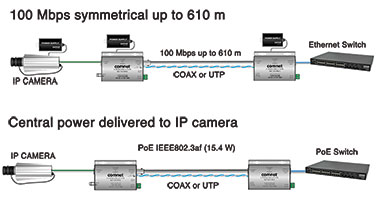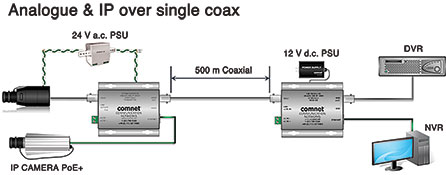
Within networking, the structured cabling standards offer twisted pair cabling up to a distance of 100 m and then optical fibre for distances up to the limitations of the optical technology. While these rules work well for the standard office location, the CCTV market can find itself in different physical environments and facing different challenges.
A large number of IP installations will be migrating away from analogue solutions where coaxial cable was used and in other cases, due to the nature and location of CCTV systems, twisted pair beyond 100 m and low-grade cable, such as telephone CAT3 cable, could be the preferred or possibly the only solution available. In an environment such as this you need to have a scope of transmission solutions that covers all the possible copper mediums and at the same time supports the requirements of modern IP systems such as Power over Ethernet (PoE).
In the transmission arena different technologies exist that enable Ethernet signals to be sent over non-standard cable or extended distances over standard twisted pair cable. The technologies will have different performance criteria and it is these coupled with the medium type that dictates the product selection.
Maintaining network integrity
One important feature for a copper extension product could be to maintain the network integrity. This ensures that the network speed (wire speed) of the link is maintained at either 100 Mbps or 10 Mbs and that the connection is fully symmetrical. By doing this it is possible to integrate units into an Ethernet network with complete confidence that the links in no way degrade the performance of the network as they operate at the chosen wire speed. It should also be added at this stage that the line speed selected does not have to be the data rate your traffic must pass at but rather the maximum data rate that the transmission path will support.

The ComNet CopperLine range operates in this way and supports extended distance transmission over either coaxial or twisted pair cable, with the coaxial medium specified at RG59 or better and the twisted pair CAT5 or better. At 100 Mbps distances extend to over 600 m on the minimum grade cable and if data rates are set to 10 Mbps distances can be up to 1500 m on RG59 coaxial cable. The coaxial cable solution provides a simple migration path for analogue end users with legacy coaxial installations who can run their new IP systems over the existing installed infrastructure.
Along with the data, CopperLine also provides support for PoE at either the 15.4 W (IEEE802.3af) or the 30 W (IEEE802.3at) power levels. Unfortunately passing power through copper cables is governed by the laws of physics and there is an inverse relationship between the distance and the power level that can be maintained across the link. At the 15,4 W level, CopperLine operates in a pass-through mode, where the devices outside of the CopperLine units (for example an Ethernet switch and IP camera) function as the PSE (Power Sourcing Equipment) and PD (Powered Device) respectively. CopperLine units can either be externally powered or via the PSE.

These powering options provide total flexibility, by offering the simplest installation with everything powered from the central PoE switch or the ability to deliver maximum power levels to the camera by externally powering the CopperLine devices. The ability to provide the correct power levels at the PD will be dictated by the type and quality of the cable being used and also the voltage level present at the PSE.
When it comes to Ethernet switches that can operate as PSE devices the ability to increase the voltage level at the Ethernet port could be very useful. If the voltage levels can be increased then there can be voltage drop in the cable but the voltage at the PD location could still be enough to power the connected device. In the case of IEEE802.3af, the required minimum voltage at the PD is 37 V d.c. and the maximum voltage allowed at the PSE is
57 V d.c. If the switch is one with a mains power input then it will tend not to have that ability and the level will be set at 48 V d.c. but if ComNet switches with DC input are used and the power supply can be increased on some models up to 57 V d.c. then the switch in turn will provide those levels.
When the PD requires IEEE802.3at 25.5 W power levels and a minimum voltage of 42,5 V d.c. then the game changes significantly. The ability to deliver 25,5 W at 42,5 V d.c. from a central PSE offering 48 V d.c. at distances above 100 m is impossible and so the design rational must change to that of the lower af levels. To accommodate this CopperLine PoE+ devices operate as PSE and PD devices through the link to negotiate with the Ethernet switch and camera respectively in the example shown.

By configuring in this way, either of the CopperLine devices can be used as a power injector with voltage levels up to 57 Vd.c. allowable at the device. For example, if the local (switch end) CopperLine unit was powered with 57 Vd.c. it would supply passive PoE to the remote CopperLine device that would then fully negotiate with the connected PD to supply power.
CopperLine range
ComNet offers CopperLine products in a number of permutations to simplify network integration. The af and at level PoE supporting products are available from single channel up to sixteen channel, with all units having equal numbers of in and out ports as point-to-point links only are configured. A miniature pass through or non PoE version is offered for remote locations where the smallest possible form factor is required. This could be direct mounted within the camera enclosure if required.
For locations where more than one Ethernet connection is required in the field, Comnet Self Managed Switch (SMS) technology with integrated CopperLine port offers simple solutions. The SMS switch provides four standard 10/100 ports with the options for PoE levels up to 30 W and the fifth port being either a twisted pair or coaxial CopperLine connection. The CopperLine port can be configured for 10 Mbps or 100 Mbps operation depending on the cable type and distance required.
The range is completed with a SFP module in twisted pair configuration that can be housed in any MSA compliant SFP housing. This module gives great flexibility to network implementation as the design radius around any Ethernet switch is now greatly increased by the integrated CopperLine technology. Via a simple converter cable or adaptor the module presents a BNC connector and enables coaxial cable runs to terminate directly on the Ethernet switch. Another possible use for the SFP module could be in a 60 W PoE media converter that ComNet can supply. If used with these devices a 60 W IP camera can be installed with the Ethernet signal passing over legacy coaxial cabling or extended twisted pair runs.
Low quality twisted pair
If your provided medium is low quality copper, such as CAT3 telephone cable, then the solution is based around VDSL2 transmission technology. Many readers will be familiar with ADSL technology as that which brings the broadband service to homes and offices and this operates on the same principle. Unlike CopperLine, VDSL2 provides asymmetrical performance with different upstream and downstream data rates and also a diminishing return on throughput based on an increasing transmission distance. A benefit of the reducing throughput is the ability to extend distances, well beyond that of the CopperLine technology, with up to 2 km on coaxial cable and 3 km on CAT3 twisted pair achievable. In the twisted pair format only a single pair of copper wires is required so the applications can be many and varied.
Analogue and IP mixed
In certain applications, the existing analogue over coaxial solution is not being changed but the end-user would like to deploy some new IP devices in the field. If this is the case the ComNet SLOC (Security Link Over Coax) system provides an asymmetrical Ethernet channel and a single simplex analogue composite video signal over a single coaxial cable, allowing use of the existing infrastructure to carry the Ethernet signal. The system supports transmission distances up to 500 m on RG59 cable and at this distance 36 Mbps down and 4 Mbps up Ethernet speeds are supported.
The transmitter unit at the camera can also support IEEE802.3at PoE and act as a PSE. It can even be powered from an existing 24 V a.c. camera power supply and generate the PoE from this. This would support connection of a device up to 100 m away over CAT5 cable or better requiring up to 25,5 W of power.
Conclusion
IP security and surveillance systems will be deployed in locations based on the operational requirements of the particular end user. The majority of these deployments will be outside of the typical office or building environment and as a result the standard structured cabling solutions may not always be available or provide the best answer.
With their range of Extended Ethernet solutions, ComNet provides network operation over non-standard copper mediums as a reliable, proven option for end-users. The benefits of utilising existing infrastructure in any project can be significant from a financial and time perspective and those alone make it a solution that cannot be overlooked. In the case of no alternative, the ability to send Ethernet signals over very low grade twisted pair, coaxial or extended CAT5 or better could be the catalyst that enables a project to move forward.
For more information contact ComNet Europe, +44 113 307 6400, [email protected], www.comnet.net

© Technews Publishing (Pty) Ltd. | All Rights Reserved.